Opinion
Palm oil ban ill-conceived
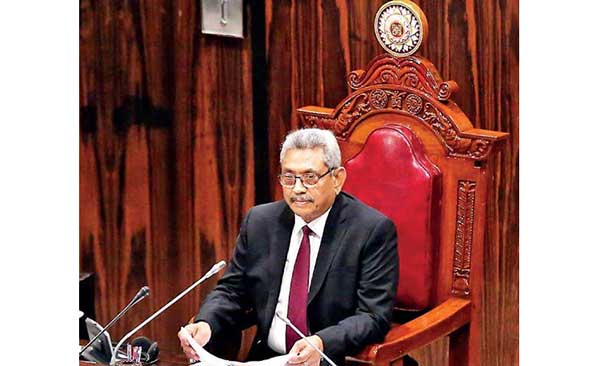
Open letter to the President
Whilst appreciating and congratulating Your Excellency on much of the new thrusts proposed in the policy statement, the writer was thoroughly dismayed by your decision to totally ban oil palm cultivation. By contrast, for example, Premier Narendra Modi, two years ago, on the advice of the Technology Commission of India (NITIAayog), decided to expand the cultivation of oil palm in India to 2 billion hectares to meet the national vegetable oil demand, in fact, replacing some low income generating arable crops. Irrigated lands are being used for part of the oil palm cultivations. It would appear that you have not consulted appropriate technocrats and academics in making this vitally important decision. I should kindly urge Your Excellency to also create a similar body as that of India here, a National Policy Commission of experts, to advise on policy matters of national interest.
It would appear that you were driven to this decision largely by the outcry of villagers living in the oil palm cultivation areas of the Southern Province that oil palm is the cause of drying of water bodies in their settlements, and some highly biased so called ‘environmentalists’, who have failed to look at the total picture relating to this highly productive and most profitable oil crop. It is the number one and most widely used global vegetable oil, producing 42% of the global oil demand from only 14.8 million ha as against soybean, the number two, which produces only 29.8%of the global oil demand from 103.8 million ha! Economic benefits of oil palm far outweigh that of coconut, tea and rubber in that comparative annual returns/ha for raw produce being Rs 612,0000, 175,000, 88,000 and 80,000 respectively, as per an estimate made by some scientists.
Misleading CEA report
Unfortunately, a scientifically highly erroneous report produced by the Central Environmental Authority (CEA) on the matter added ‘fuel to the villagers’ fire’! The report has been heavily criticised by the Coconut Research Institute and numerous other independent well-informed scientists. However, the criticisms had little impact on the Yahapalana regime which, having suspended its initial decision to expand the oil palm cultivation to 20,000ha, vacillated for years without generating a final decision!
The CEA supported the contention that oil palm dries up the soil, incorrectly arguing that whereas a rubber tree transpires only 63 litres/day, oil palm transpires 500-600 litres; the oft quoted figures, however, are 1,300 and 1100 mm/year for oil palm and rubber respectively, in the literature, or 120l/rubber tree and 300l/oil palm tree/day. The mean annual rainfall in the wet zone, where both these crops are grown, is as high as 3000 mm, well in excess of the crop requirements! The CEA seems to be unaware that evapo-transpiration rates of crops are calculated on unit area basis and not per tree or plant basis! Whereas the standard tree density of rubber is 520/ha that of oil palm is only 143, implying then that the two crops transpire comparable amounts of water per unit area of land based on our above cited per tree values. Furthermore the reported green water footprint of oil palm, that is the component of water received from precipitation that is stored in the root zone of the soil and is evaporated, transpired or incorporated into plants, is 19,148 cubic metres/ha for oil palm as against 32,410 for rubber.
It is more than evident that over the years, global warming leading to climatic changes as well as increased water use by the increasing population caused this situation. In my own experience, a beautiful stream that ran across my farm in Kandy which I bought in 1992, dried over the years and by 2015 even traces of its existence disappeared! As excessive water consumption is the main argument against oil palm cultivation, it is vital that a hydrological study be conducted, comparing history and current status of water bodies in an exclusively rubber growing area, as against an oil palm areas in the wet zone to convince the concerned parties.
Coming back to the CEA report referred to above, some 12 points had been cited there critical of oil palm, but nearly all of them have been refuted by the CRI, the organization mandated for R & D on oil palm and a host of independent scientists well versed in the science of oil palm. It is unfortunate that you failed to consult them before making the vital decision.
Palm oil and health
Some concern has been expressed over some bi-products formed during palm oil processing supposed to be carcinogenic, but the latest research has established that consuming palm oil in moderation hardly poses a health risk. Whilst some saturated fatty acids in palm oil may be cholesterol elevating, coconut oil it can be argued to be worse in that regard, in that the cholesterol elevating saturated fatty acid content is more. Of course coconut oil has numerous health benefit too, and although it was downgraded as an ‘artery-clogging tropical oil’, several decades ago, it has now become ‘the darling oil of the west’. Further, apart from others, the high (38%) monounsaturated fat content in palm oil has a distinct health benefit, in that it decreases the LDL (bad) cholesterol.
GMOA’s letter
It is ridiculous that the GMOA, which often pokes its nose into matters that it is not thoroughly conversant with, has thanked you for banning oil palm. Have they studied all aspects of the issue: economics, environment and health in-depth before making such utterances? I should refer to an exhaustive review that appeared in an issue of the journal ‘Nutrients’, 2019, on the subject of oil palm by Eva Gestiro and nine co-authors which has discussed the health effects and other matters thoroughly. On a previous occasion too the GMOA had strongly advocated reverting to traditional rice varieties, little realising that they yield only 25-30% of the new improved varieties; and in doing so we will be compelled to import bulk of our rice requirement! Moreover, we have many new rice varieties with similar health and nutritional benefits as the traditional ones, but yielding several fold more!
Alternative lands for oil palm
or other uses
There are some 60,000 ha of uncultivated paddy fields essentially in the wet zone which can be used for other purposes. They are left fallow as returns on investment in rice farming are low. One option is possibly oil palm cultivation, after draining the excess water. In such lands the excess water could be collected in ponds at the bottom of the catena and used for fish culture or irrigation. Raised beds can be prepared, as done for cultivation of coconut in Thailand and Indonesia, in highly ill-drained soils, and used for coconut, oil palm or market gardening. The current provisions of the Agrarian Development Act prohibit alternative use of these lands, but, surely, the Act can be amended.
Coconut oil alternative
It has been suggested by many that we should promote coconut oil as an alternative to palm oil, and the extent under coconut be expanded for the purpose. At the current mean national yield of coconut oil (0.8 M/ha) and the global mean palm oil yield of 3.8-4.0 Mt/ha, we would need five times more land to produce coconut oil than palm oil; and where is the land? With global warming and air temperatures rising, especially in the dry months in the dry zone, there is a serious problem of pollen germination and nut setting in coconut in this area. Hence land expansion for coconut is very limited therein. There is little or no land in the intermediate and wet zones for additional coconut growing. One option, however, appears to be cultivation of coconut as a shade tree for tea in the low and mid countries, and the CRI & TRI research has established that this is feasible. The demand, however, for both virgin and conventional coconut oils appears to have decreased since 2015, whereas that for coconut water is rapidly increasing. In fact the forecast for coconut water demand is to double over the next five years from 2. 25 to 4.5 billion USD. Consequently, the demand for our king coconut is growing, and it would appear more prudent to cultivate king coconut in available lands than producing nuts or oil!
Moving totally to organic farming
Promoting organic farming as far as possible is desirable, but achieving the above target stated in your speech is far- fetched, given the fact that global organic farm cover is increasing only by about 10% of its current extent, which is only 2% of the total global farm cover! Of this 66% is in pastures, and only the balance is in crops! There is much ongoing research in organic farming, especially in the field of microbial fertilizers. However, widely applicable technologies are yet to come. As regards microbial fertilizers, the soil medium should have the nutrients for effective uptake by microbes, implying that the soil should anyway be replenished regularly with nutrients, chemically or organically, except for nitrogen, which legumes and certain other crops can fix from the atmosphere.
So conventional farming cannot be easily replaced. What is more important in the short term is to correct the shortcomings thereof. One important area is judicious use of agrochemicals for which a massive farmer training effort is needed. This necessitates an effective extension service, the current one being in shambles! So please get the government to address this issue. At the same time research and technology output is rapidly declining, mainly because qualified technocrats from research institutes are leaving for greener pastures, especially to the universities where the total remuneration package is more than double for many comparable posts. This lateral brain drain now appears to be more serious than the vertical!
We trust you would give serious consideration to the issues cited above.
Dr PARAKRAMA WAIDYANATHA
- News Advertiesment
See Kapruka’s top selling online shopping categories such as Toys, Grocery, Flowers, Birthday Cakes, Fruits, Chocolates, Clothing and Electronics. Also see Kapruka’s unique online services such as Money Remittence,News, Courier/Delivery, Food Delivery and over 700 top brands. Also get products from Amazon & Ebay via Kapruka Gloabal Shop into Sri Lanka.
Opinion
Take Human Rights seriously, not so much the council or office
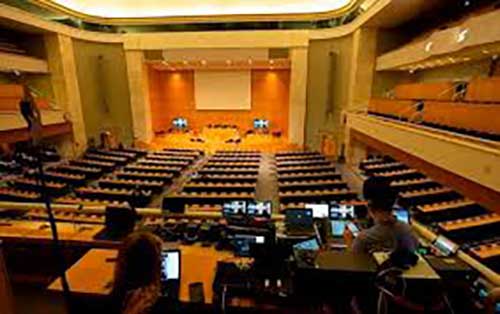
By Dr Laksiri Fernando
The 46th Session of the UN Human Rights Council started on 22 February morning with obvious hiccups. The Office, to mean the Office of the UN High Commissioner for Human Rights, finally decided to hold all sessions virtually online, only the President of the Council and the assistants in the high table sitting at the UN Assembly Hall in Geneva. The President, Ms. Nazhat Shammen Khan, Ambassador from Fiji in Geneva, wearing a saree, was graceful in the chair with empty seats surrounding.
In the opening session, the UN General Assembly President, UN General Secretary, UN High Commissioner for Human Rights, and Head of Foreign Affairs, Switzerland (as the host country), addressed remotely the session. In fact, there was no need for Switzerland to have a special place, as the UN is independent from any host country. Switzerland is fairly ok, however, if this tradition is followed, the UN General Assembly may have to give a special place to the US in New York.
Initial Addresses
UN General Secretary, Antonio Guterres’ address could have been quite exemplary if he gave a proper balance to the developed and developing countries. He talked about racism and fight against racism but did not mention where racism is overwhelmingly rampant (US and Europe) and what to do about it. Outlining the human rights implications of Covid-19 pandemic, he made quite a good analysis. It was nice for him to say, ‘human rights are our blood line (equality), our lifeline (for peace) and our frontline (to fight against violations).’ However, in the fight against violations, he apparently forgot about the ‘blood line’ or the ‘lifeline’ quite necessary not to aggravate situations through partiality and bias. He never talked about the importance of human rights education or promoting human rights awareness in all countries.
His final assault was on Myanmar. Although he did not call ‘genocide,’ he denounced the treatment of Rohingyas as ethnic cleansing without mentioning any terrorist group/s within. His call for the release of Aung San Suu Kyi and other civilian leaders undoubtedly should be a common call of all. However, he did not leave any opening for a dialogue with the military leaders or bring back a dialogue between Aung San and Min Aung, the military leader. With a proper mediation, it is not impossible. Calling for a complete overhaul as the young demonstrators idealistically claim might not be realistic.
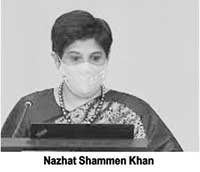 High Commissioner Michelle Bachelet’s address was brief and uncontroversial this time without mentioning any country or region. It is clear by now perhaps she is not the real author of the Report against Sri Lanka, but someone probably hired by the so-called core-group led by Britain. Her major points were related to the coronavirus pandemic trying to highlight some of the socio-economic disparities and imbalances of policy making that have emerged as a result. The neglect of women, minorities, and the marginalized sections of society were emphasized. But the poor was not mentioned. As a former medical doctor, she also opted to highlight some of the medical issues underpinning the crisis.
High Commissioner Michelle Bachelet’s address was brief and uncontroversial this time without mentioning any country or region. It is clear by now perhaps she is not the real author of the Report against Sri Lanka, but someone probably hired by the so-called core-group led by Britain. Her major points were related to the coronavirus pandemic trying to highlight some of the socio-economic disparities and imbalances of policy making that have emerged as a result. The neglect of women, minorities, and the marginalized sections of society were emphasized. But the poor was not mentioned. As a former medical doctor, she also opted to highlight some of the medical issues underpinning the crisis.
Then came the statements from different countries in the first meeting in the following order: Uzbekistan, Colombia, Lithuania, Afghanistan, Poland, Venezuela, Finland, Fiji, Moldova, Georgia, Kazakhstan, Equatorial Guinea, Vietnam, Belgium, and Morocco. The obvious purposes of these statements were different. Some countries were apparently canvassing for getting into the Human Rights Council at the next turn perhaps for the purpose of prestige. Some others were playing regional politics against their perceived enemies. This was very clear when Lithuania and Poland started attacking Russia.
But there were very sincere human rights presentations as well. One was the statement by the President of Afghanistan, Mohammad Ashraf Ghani. He outlined the devastating effects that Afghanistan had to undergo during the last 40 years, because of foreign interferences. The initial support to Taliban by big powers was hinted. His kind appeal was to the UN was to go ‘beyond discourse to practice’ giving equal chance to the poor and the developing countries to involve without discrimination.
Controversial Presentations
China’s Foreign Affairs Minister, Wang Yi, made his presentation almost at the end of the first day. This is apparently the first time that China had directly addressed the Human Rights Council. Beginning with outlining the devastating repercussions of the coronavirus pandemic he stressed that the world should face the challenges through ‘solidarity and cooperation.’ He broadened the concept to human rights solidarity and cooperation. His expressed views were quite different to the others, particularly to the Western ones.
He frankly said that what he expresses are the views of China on human rights without claiming those are absolute truths or forcing others to believe or implement them. There were four main concepts that he put forward before the member countries. First, he said, “We should embrace a human rights philosophy that centres on the people. The people’s interests are where the human rights cause starts and ends.” Second, he said, “we should uphold both universality and particularity of human rights. Peace, development, equity, justice, democracy, and freedom are common values shared by all humanity and recognized by all countries.” “On the other hand,” he said, “countries must promote and protect human rights in light of their national realities and the needs of their people.”
“Third,” he said, “we should systemically advance all aspects of human rights. Human rights are an all-encompassing concept. They include civil and political rights as well as economic, social, and cultural rights.” He then emphasized, “Among them, the rights to subsistence and development are the basic human rights of paramount importance.” Fourth, “we should continue to promote international dialogue and cooperation on human rights. Global human rights governance should be advanced through consultation among all countries.”
It was on the same first day before China, that the United Kingdom launched its barrage against several countries not sparing Sri Lanka. The Foreign Secretary, Dominic Raab, delivered the statement from top to bottom attacking alleged violating countries on human rights. But there was no mentioning of Israel for the repression of Palestinians or the systemic racism rampaging in the United States, including the 6 January attacks on the Capitol by extremist/terrorist groups.
His first sermon was on Myanmar without acknowledging the British atrocities or mismanagement of this poor and diverse country during the colonial period. He was quite jubilant over implementing sanctions and other restrictions over the country. Many sanctions, in my opinion, are extortions. Undoubtedly, Aung San Suu Kyi and other leaders should be released, and democracy restored. This is a task of the whole council and when one or two countries try to grab the credit, there can be obvious reservations of others.
His further scathing attacks were against Belarus, Russia, and China. Some appeared factually correct but not necessarily the approach or the motives genuine. The following is the way he came around Sri Lanka. He said,
“Finally, we will continue to lead action in this Council: on Syria, as we do at each session; on South Sudan; and on Sri Lanka, where we will present a new resolution to maintain the focus on reconciliation and on accountability.”
‘Action’ to him basically means repeatedly passing resolutions, of course imposing economic and other sanctions. He said, “as we do at each session”; like bullying poor or weak countries at each session. Can there be a resolution against Russia or China? I doubt it.
What would be the purpose of presenting a resolution against Sri Lanka? As he said, “to maintain the focus on reconciliation and on accountability.” This will satisfy neither the Tamil militants nor the Sinhalese masses. But it might satisfy the crafty Opposition (proxy of the defeated last government). This is not going to be based on any of the actual measures that Sri Lanka has taken or not taken on reconciliation or accountability. But based on the ‘Authoritarian and Hypocritical Report’ that some anti-Sri Lankans have drafted within the Office of the High Commissioner for Human Rights. This what I have discussed in my last article.
In this context, successful or not, the statement made by the Sri Lanka’s Minister of External Affairs, Dinesh Gunawardena, in rejecting any resolution based on the foxy Report of the Office of the UN High Commissioner for Human Rights, in my concerned opinion, is absolutely correct.
Opinion
President’s energy directives ignored by the Power Ministry: Another Point of View

Dr Tilak Siyambalapitiya
Dr Janaka Rathnasiri laments (The Island 19 Feb 2021) that the Power Ministry has ignored the President’s directive to draw 70% of energy from renewable sources by 2030. I saw the approved costs of electricity production for 2019, published by the Public Utilities Commission (PUCSL).
PUCSL has also approved the prices to sell electricity to customers. Although various customers pay at various “approved” prices, the average income from such “approved” prices in 2019 was Rs 17.02 per unit. It is not only the Ministry, according to Dr Rathnasiri, ignoring the President; PUCSL is also breaking the law, which says prices and approved costs should be equal.
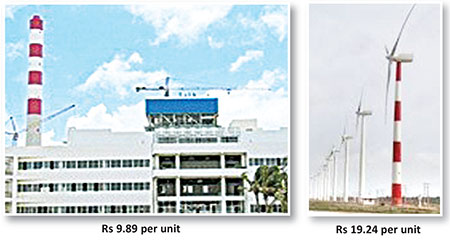 So there is already an illegal gap of Rs 21.59 minus 17.02 = Rs 4.57 per unit of electricity sold. If electricity prices are not to be increased, as stated by many in the government and PUCSL, let us say the following: Distribution costs should decrease by 0.57 Rs per unit. Generation costs should decrease by Rs 4.00 per unit.
So there is already an illegal gap of Rs 21.59 minus 17.02 = Rs 4.57 per unit of electricity sold. If electricity prices are not to be increased, as stated by many in the government and PUCSL, let us say the following: Distribution costs should decrease by 0.57 Rs per unit. Generation costs should decrease by Rs 4.00 per unit.
PUCSL also published the approved cost of purchasing or producing electricity from various sources for 2019. The actual energy values were different to what was approved, but let us stick to PUCSL approved figures:
I suggest Dr Rathnasiri fills-up the following table, to show how much electricity will cost in 2030 to produce and deliver, if the President’s 70% target is to be achieved and for PUCSL to abide by the law. Let us assume that electricity requirement in 2030 will be double that of 2019.
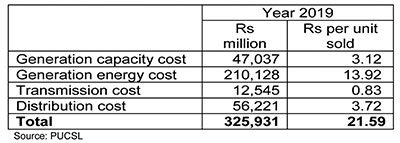 Since PUCSL has to save Rs 4 from 13.92, the average selling price for energy should be Rs 13.92 minus 4.00 = Rs 9.92. With a target network loss of 7% (in 2019 it was 8.4%), the average cost of production has to be Rs 9.27 per unit. Eight cages have to be filled-up by Dr Rathnasiri.
Since PUCSL has to save Rs 4 from 13.92, the average selling price for energy should be Rs 13.92 minus 4.00 = Rs 9.92. With a target network loss of 7% (in 2019 it was 8.4%), the average cost of production has to be Rs 9.27 per unit. Eight cages have to be filled-up by Dr Rathnasiri.
In 2012, PUCSL approved the energy cost of electricity produced from coal power to be 6.33 Rs per kWh. In 2019, PUCSL approved 9.89 (56% increase). For renewable energy, it was 13.69 in 2012, and 19.24 in 2019 (a 40% increase, but double the price of electricity from coal fired generation). In 2012, rooftop solar was not paid for: only give and take, but now paid Rs 22, against Rs 9.89 from coal. There seems to be something wrong. The price reductions of renewable energy being promised, being insulated from rupee depreciation, are not happening? Either Sri Lanka must be paying too little for coal, or it may be renewable energy is severely over-priced?
On coal we hear only of some corruption every now and then; so Sri Lanka cannot be paying less than it costs, for coal.
Enough money even to donate
vaccines
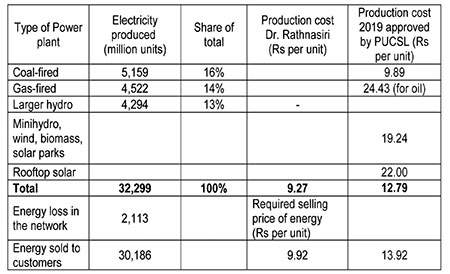 Another reason for the Ministry of Power to ignore the President’s directive may be the Ministry’s previous experience with similar Presidential directives. In 2015, the President at that time cancelled the Sampur coal-fired power plant, and the Ministry faithfully obliged. That President and that Prime Minister then played ball games with more power plants until they were thrown out of power, leaving a two-billion-dollar deficit (still increasing) in the power sector. Not a single power plant of any description was built.
Another reason for the Ministry of Power to ignore the President’s directive may be the Ministry’s previous experience with similar Presidential directives. In 2015, the President at that time cancelled the Sampur coal-fired power plant, and the Ministry faithfully obliged. That President and that Prime Minister then played ball games with more power plants until they were thrown out of power, leaving a two-billion-dollar deficit (still increasing) in the power sector. Not a single power plant of any description was built.
Where is this deficit? You do not have to look far. In the second table, replace 24.43 with 9.89, to reflect what would have happened if Sampur was allowed to be built. The value 12.79 will go down to 8.55, well below the target of Rs 9.27 per unit to produce. Not only would CEB and LECO report profits, but the government too could have asked for an overdraft from CEB to tide over any cash shortfalls in the treasury. All this with no increase in customer prices. Producers of electricity from renewable energy could enjoy the price of 19.24 Rs per unit. And that blooming thing on your rooftop can continue to enjoy Rs 22 per unit. The Minister of Power, whom Dr Rathnasiri wants to replace with an army officer, would have been the happiest.
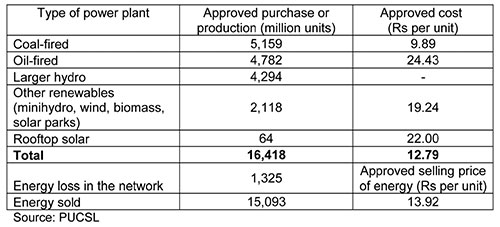 In the absence of Sampur (PUCSL’s letter signed by Chairman Saliya Mathew confirmed cancellation and asked CEB not to build it), PUCSL approved electricity to be produced at Rs 21.59 and sold at Rs 17.02 per unit. The annual loss would be Rs (21.59 – 17.02) x 15,093 = Rs 69 billion per year of approved financial loss. Sri Lanka has a Telecom regulator, an Insurance regulator, a Banking regulator, who never approve prices below costs. Sometime ago the telecom regulator asked the operators to raise the prices, when operators were proposing to reduce prices amidst a price war. But the electricity industry regulator is different: he approves costs amounting to 27% more than the price, not just once but, but continuously for ten long years !
In the absence of Sampur (PUCSL’s letter signed by Chairman Saliya Mathew confirmed cancellation and asked CEB not to build it), PUCSL approved electricity to be produced at Rs 21.59 and sold at Rs 17.02 per unit. The annual loss would be Rs (21.59 – 17.02) x 15,093 = Rs 69 billion per year of approved financial loss. Sri Lanka has a Telecom regulator, an Insurance regulator, a Banking regulator, who never approve prices below costs. Sometime ago the telecom regulator asked the operators to raise the prices, when operators were proposing to reduce prices amidst a price war. But the electricity industry regulator is different: he approves costs amounting to 27% more than the price, not just once but, but continuously for ten long years !
That is 370 million dollars per year as of 2019, the economy is spending, and for years to come, to burn oil (and say we have saved the environment). Did the Minister of Health say we are short of 160 million dollars to buy 40 million doses of the vaccine? Well, being a former Minister of Power, she now knows which Presidential “order” of 2015 is bleeding the economy of 370 million dollars per year, adequate to buy all vaccines and donate an equal amount to a needy country.
Prices are the production costs approved by PUCSL for 2019. The selling price approved by the same PUCSL was Rs 9.27 per unit.
Opinion
Confusion on NGOs and NSOs in Sri Lanka
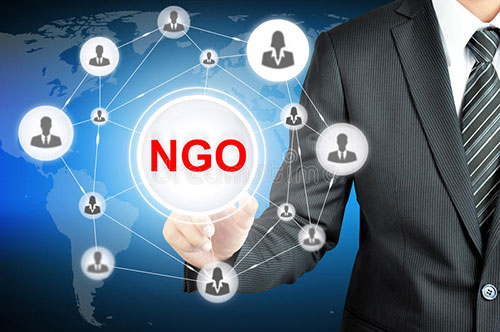
If you listen to politicians and journalists here, you will hear of that curious creature rajya novana sanvidane, a Non-State Organization (NSO). Where do you get them? In the uninstructed and dead minds of those who use those terms. In the real world, where politicians and journalists have developed minds, there are Non-Governmental Organizations (NGO). The United Nations is an organization set up by state parties, not by governments. It is true that agents of states, governments, make the United Nations work or fail. Governments may change but not the states, except rarely. When Eritrea broke away from Ethiopia, a new state was formed and was so recognised by the United Nations. However, the LTTE that tried to set up another state was crushed by the established state that it tried to break away from, and the UN had nothing to do with them.
This entirely unnecessary confusion, created out of ignorance, is so destructive that organizations completely loyal to the existing state, are made to be traitorous outfits, for they are ‘non-state organizations’ within the state. There are citizens of each state, but no citizens of any government. Government is but an instrument of the state. In most states there are organizations, neither of the state nor of government: religious organizations including churches. But none of them is beyond the pale of the state.
Those that speak of rajya novana sanvidane give that name partly because they have no idea of the origin of non-governmental organizations. NGOs came into the limelight, as donor agencies, noticed that some governments, in East Africa, in particular, did not have the capacity and the integrity to use the resources that they provided. They construed, about 1970, that NGOs would be a solution to the problem. Little did they realize that some NGOs themselves would become dens of thieves and brigands. I have not seen any evaluation of the performance of NGOs in any country. There was an incomplete essay written by Dr. Susantha Gunatilleka. NGOs are alternatives to the government, not to the state.
Our Constitution emphatically draws a distinction between the government and state, and lays down that the President is both Head of Government and Head of State (Read Article 2 and Article 30 of the Constitution.) It is as head of state that, he/she is the Commander of the Armed Forces, appoints and receives ambassadors and addresses Parliament annually, when a prorogued Parliament, reconvenes. He/she presides over the Cabinet as head of government. The distinction is most clear, in practice, in Britain where Queen Elizabeth is the head of state and Boris Johnson is the Prime Minister and head of government. However, in principle, Johnson is the Queen’s First Minister appointed by the sovereign, and resigns by advising her of his decision to do so.
In the US and in India the term ‘state’ has special significance. In India there is a ‘rajya sabha’ (the Council of States) whose members represent constituent States and Union Territories. Pretty much the same is true of the United States. In the US, executive power is vested in the President and heads the administration, government in our parlance. The Head of State does not come into the Constitution but those functions that one associates with a head of state are in the US performed by the President of the Republic. The US President does not speak of my state (mage rajaya) but of my administration, (mage anduva). Annually, he addresses Congress on the State of the Union. Our present President must be entirely familiar with all this, having lived there as a citizen of the US for over a decade. It is baffling when someone speaks of a past state as a traitor to that same state. It is probable that a government was a traitor to the state. ‘Treason against the United States, shall consist only in levying war against them, or in adhering to their (States’) enemies, giving them aid and comfort’. That a state was a traitor to the same state is gobbledygook.
Apart from probable confusion that we spoke of in the previous paragraph, it is probable that a president and other members of a government, including members of the governing party here, find it grandiloquent to speak of his/her/their state (mage/ape rajaya), rather than my government (mage anduva) or Sirisena anduva’ and not Sirisena state; it was common to talk of ‘ape anduva’ in 1956; politicians in 1956 were far more literate then than they are now.
When translating from another language, make sure that you understand a bit of the history of the concept that you translate. A public school in the US is not the same as a public school in the UK.
MAHADENAMUTTA









